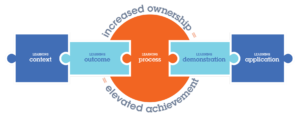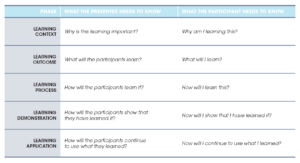Share this article.
In their Standards for Professional Learning, the professional learning association Learning Forward names “Promote active engagement” as a standard for effective Learning Designs.
“Active engagement in professional learning promotes change in educator practice and student learning. Active engagement occurs when learners interact during the learning process with the content and with one another. Educator collaborative learning consistently produces strong, positive effects on achievement of learning outcomes. Active engagement respects adults as professionals and gives them significant voice and choice in shaping their own learning. Through active engagement, educators construct personal meaning of their learning, are more committed to its success, and identify authentic applications for their learning. Active learning processes promote deep understanding of new learning and increase motivation to implement it. Active learning processes include discussion and dialogue, writing, demonstrations, inquiry, reflection, metacognition, co-construction of knowledge, practice with feedback, coaching, modeling, and problem solving. Through exploration of individual and collective experiences, learners actively construct, analyze, evaluate, and synthesize knowledge and practices”
Therefore, it is critical for presenters to deliberately make the decisions that will increase adults’ engagement in learning and overall motivation.
One of the most effective decisions a presenter can make is to use a focused Learning Model for Adults that guides and focuses session planning and delivery. Elevated Achievement’s Learning Model is driven by the learner and answers the question—What does a learner need to know in order to better own his or her learning?
In another of our articles, we provided an overview of the Learning Model for Adults and its five learner-centered phases: setting the Learning Context, stating the Learning Outcome, engaging in the Learning Process, producing the Learning Demonstration, and implementing the Learning Application. In this series of articles, we will discuss the sequence of planning a focused session and take an in-depth look at each of the five phases that cultivate skills in adults that will support students’ learnership and elevated achievement.
The Sequence of Planning
Madeline Hunter described teaching as a constant stream of decisions made before, during, and after interactions with students. And, no matter the age of the learner and no matter the label of the teacher, teaching is teaching. Therefore, the purpose of delineating this planning sequence for a focused Learning Model for Adults is to support a presenter to reflect on their own decision-making as they decide what they and their adult learners need to know for each professional learning session.
The purpose of delineating a planning sequence is to support the presenter to reflect on their own decision-making.
When planning a session, the presenter must take into consideration both the design and delivery of the session.
This helps the presenter answer, “How will you decide what to do?” and, more importantly, “Why did you decide that?”
This clarity of decision-making will allow your participants to understand their role in their own learning. That is, if you let them in on your decision-making. Thus, throughout the session, share with your participants your plan and help them to answer the following questions:
- Why am I learning this?
- What will I learn?
- How will I learn this?
- How will I show that I have learned it?
- How will I continue to use what I learned?
What’s Next in Learnership?
As we’ve said before, developing ownership of learning, aka learnership, is the life skill our children need to be successful in the future. That’s why developed this series of articles that takes in-depth looks at each of the five phases of the Learning Model for Adults that develops learnership, their value to participants, and their value to presenters. In each article we will provide presenters with the planning questions and tools needed to help adults develop skills that elevate student achievement.
So, use these links to get the knowledge and tools school-site administrators and/or presenters need to plan and implement a focused Learning Model for each and every professional learning session. Because when you do, the adults in your educational community will gain the skills they need to support their students in developing learnership.
Continue the Learning
Check out these articles and resources to continue your learning about this topic…
The Learning Brief
In this article you learned…
- Active engagement respects adults, gives them significant voice and choice in shaping their own learning, promotes deep understanding of new learning, and increases motivation to implement it.
- The purpose of a focused Learning Model for Adults is to support a presenter to reflect on their own decision-making as they decide what they and their participants need to know for each session, thereby increasing adult learners’ engagement and motivation.
- Presenters utilizing a Learning Model for Adults will be supporting their participants in knowing what they are learning, why they are learning it, how they will learn it, how they will show they have learned it, and how they will continue to use what they learned.
Can you imagine building an environment full of motivated, engaged, and eager students who own their learning?
We can.




